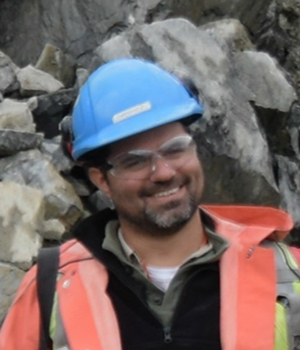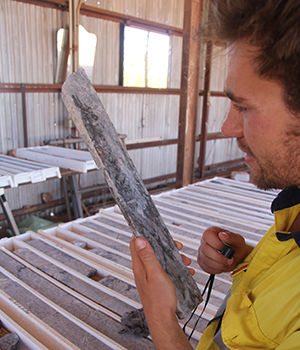Back to program
From index to lithium mine: geology, exploration and discoveries
Tuesday, November 21, 2023
Room 301A - COREM
Session organizer
Fabien Solgadi
MRNF
Lithium is attracting unprecedented economic, scientific and technical interest from the geoscientific community, particularly in Quebec. The aim of this session is to present new developments in geological models and exploration methods, as well as recent discoveries in the province and elsewhere.
This session will be offered in French and in English.
9:30 a.m.
Controls on lithium pegmatites in Western Australia
Conference details
Authors: John Grigson , Tony Kemp, Steffen Hagemann, Marcus Sweetapple (University of Western Australia) and Mike Grigson (Arc Minerals Consultants)
Lithium is a critical metal in the pivot to battery storage of renewable energies and economic decarbonisation. Around half of the global supply of raw lithium materials comes from pegmatite deposits, and delineation and development of these deposits in Western Australia has burgeoned in the past decade. Current exploration for lithium pegmatites relies heavily on surface discoveries in existing mineral fields, and application of a dated genetic model with ‘parent granites’ and ‘pegmatite goldilocks zones’. Greenfields discoveries will be necessary to meet growing lithium demand, and require a more sophisticated, mineral-systems understanding of the controls on lithium pegmatites.
Lithium pegmatite deposits in Western Australia are preferentially sited in high-strain, constrictional, lower-amphibolite facies domains within shear zones cross-cutting greenstone belts of the Archaean Pilbara and Yilgarn cratons. The deposits comprise stacks of individual intrusions that are hundreds of metres long and tens of metres thick, and exhibit en echelon and conjugated geometry, lensoid shapes, sharp wall-rock contacts, and tapered terminations. The intrusions are syn-kinematic and reflect dilational shear fracturing during episodes of magmatic overpressure below rheological
transitions in shear zones otherwise transmitting melts along grain boundaries.
Intrusions in the deposits are generally composites of two distinct and sequentially emplaced types of metal-rich melts. The early and most voluminous melts were lithium-saturated and crystallised as pegmatites with typical spodumene-quartz-microcline-muscovite assemblages that are megacrystic in the absence of solid-state deformation. Late melts were saturated in high field strength elements and crystallised as aplites with typical albite-quartz and trace spessartine-apatite-tantalite-cassiterite assemblages. The late melts typically exploited the pre-existing pegmatites rather than the wall-rocks, due to a lower strength threshold, and formed concordant to discordant tabular bodies or grain-scale infiltrations.
Lithium pegmatite deposits have spatial and isotopic overlaps with suites of potassic, crustally derived two-mica monzogranites and granitic pegmatites, and these are the most likely source of metal-rich melts. However, these granitic suites do not exhibit syn-kinematic emplacement and are everywhere deformed in the solid-state by the shear zones that host lithium pegmatite deposits. Importantly the least-deformed granitic pegmatites are enriched in lithium, whereas their deformed equivalents are depleted in lithium. The structural and chemical relationships are reconciled with strain-assisted, selective partial melting of the granitic rocks, which released lithium-rich melts into active shear-zone arrays.
The foregoing controls on lithium pegmatite deposits in Western Australia can be translated into step-wise, scale-appropriate and mappable exploration criteria that are applicable in other terranes globally.
10:25 a.m.
Characterization of pegmatites in the La Motte Batholith area, Abitibi Subprovince, and the implication for exploration
Conference details
Authors: Sabrine Rajhi, Marc Legault (IRME-UQAT), Hubert Mvondo (MRNF-UQAT) and Robin Potvin (UQAT)
This project involves the study of the characteristics of pegmatites in the La Motte Batholith (LMB) area in Abitibi. This area lies at the heart of the Rouyn-Noranda–Amos–Val d’Or triangle, between 20 km and 40 km west of the North American Lithium Mine (101.9 Mt at 1.06% Li2O; Sayona Québec). The area hosts several critical and strategic minerals (CSM) mineralizations, such as the Authier deposit, which are associated with Li-Cs-Ta pegmatites. A mapping and sampling campaign was carried out in the summer of 2022 to characterize the mineralogy and geochemistry of pegmatites in the area in order to better target lithium exploration. This characterization made it possible to distinguish different types of pegmatites in the LMB area, from clusters of barren rock to spodumene dykes. Within the LMB, pegmatitic facies of the intrusion display geochemical characteristics comparable to those of the pegmatite dykes that cut it, suggesting a genetic link between the two facies despite differences in age of a few million years (Ducharme et al., 1997). The results of whole rock analyses also confirm that the values of the elemental ratios (K/Rb, K/Cs, Nb/Ta, Mg/Li and Zr/Hf) of lithium dykes are lower than those of barren dykes, independently of the location where sampling was carried out in the dyke. The use of these criteria therefore makes it possible to target highly fractionated dykes where spodumene has not been identified to date. The study also examined the use of microprobe analyses of K-feldspar and micas to assess the fertility of pegmatites. This work reveals that the K/Rb and K/Cs ratios of these minerals are similar to those of whole rock analyses, confirming the degree of fractionation of the LMB pegmatites. These low ratios reflect pronounced fractionation of mineralized pegmatites, in agreement with the conclusions of Cerný (1989) and other subsequent research. These observations emphasize the need for further stripping and mapping around the LMB in order to better evaluate some promising Li occurrences in this area.
11:05 a.m.
The James Bay Lithium Project – From Discovery to Development
Conference details
Despite its discovery over 50 years ago, the James Bay Lithium Project (also known as the Cyr Deposit) has seen relatively little modern exploration and has not been subject to any significant academic studies or research. Although sharing numerous characteristics of typical LCT pegmatites, the deposit exhibits a unique structural history of emplacement and interaction with the host paragneisses. This presentation aims will highlight the history of exploration on the property, present some high-level hypotheses of structural models and provide the reader an insight into exploration plans for the coming winter.
11:30 a.m.
The CV5 Spodumene Pegmatite – A Grassroots Discovery to a World Class Lithium Deposit
Conference details
At the Corvette Property, lithium mineralization is observed to occur within quartz-feldspar Li-Cs-Ta (LCT) pegmatites, which may be exposed at surface as high relief ‘whale-back’ landforms due to their naturally resistive nature. However, drilling has confirmed that the LCT pegmatite may also occupy topographic lows, interpreted to be a result of preferential fracturing and movement of large pegmatite blocks by overlying glaciers.
The LCT pegmatite occurrences form multiple distinct clusters along an approximate 1-km wide and 25+ km long corridor extending across the Property (the CV Trend). The trend is highlighted by the CV5 Spodumene Pegmatite with a maiden mineral resource1 estimate of 109.2 Mt at 1.42% Li2O and 160 ppm Ta2O5, inferred. Through the April 2023 drill program, the CV5 Pegmatite has been traced by drilling over a 3.7 km strike length, drill hole to drill hole, and remains open along strike at both ends and to depth along most of its length. More than 90% of the pegmatite volume at CV5 is hosted within a single, large, principal spodumene pegmatite dyke, which is flanked on both sides by multiple, subordinate, sub-parallel trending dykes. True widths of this principal dyke range from ~8 m to ~130 m, and may pinch and swell aggressively along strike, as well as up and down dip. It is primarily the thickest at near-surface to moderate depths (<225 m), forming a relatively bulbous, elongated shape, which may flair to surface and to depth variably along its length. Additionally, the CV5 Pegmatite displays no apparent indication of deformation and is non-concordant to the regional fabric, having a steep northerly dip.
Lithium mineralization at CV5 is comprised of typically decimetre to metre scale spodumene crystals which liberate effectively at coarse crush size. An initial dense media separation (DMS) test on CV5 material returned a spodumene concentrate grading 5.8% Li2O at 79% recovery, strongly indicating potential for a DMS only operation to be applicable. Variability testing using heavy liquid separation (HLS) tests on samples from CV5, representing a broad range of spatial locations, gangue mineral assemblages, and head grade, returned a global recovery of >70% at the metallurgical target grade of >5.5% Li2O and <1.2% Fe2O3 for most samples, providing further support for a DMS only operation to be applicable.
1 Cut-off grade of 0.40% Li2O. Effective Date of June 25, 2023. Mineral resources are not mineral reserves as they do not have demonstrated economic viability.






